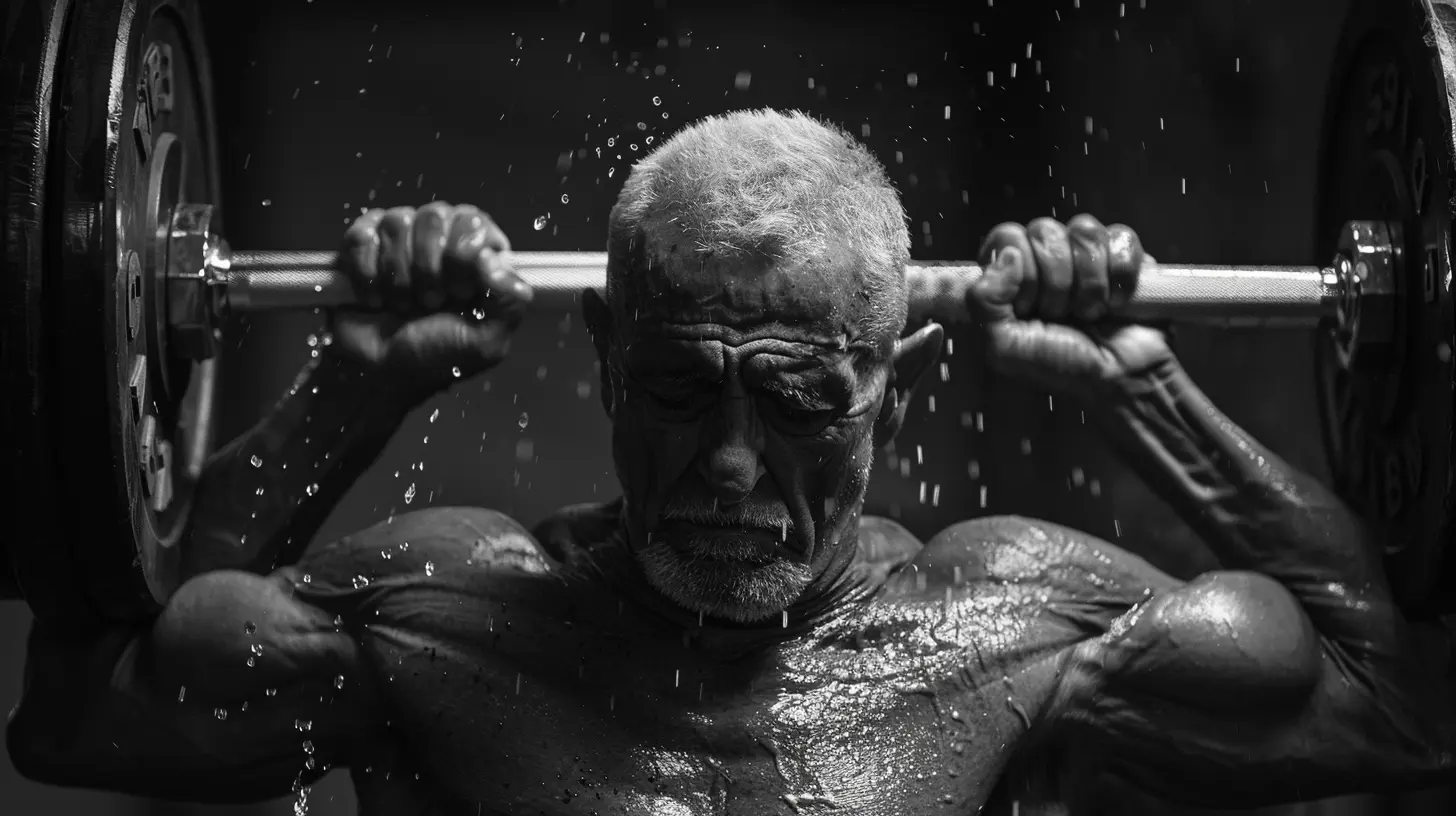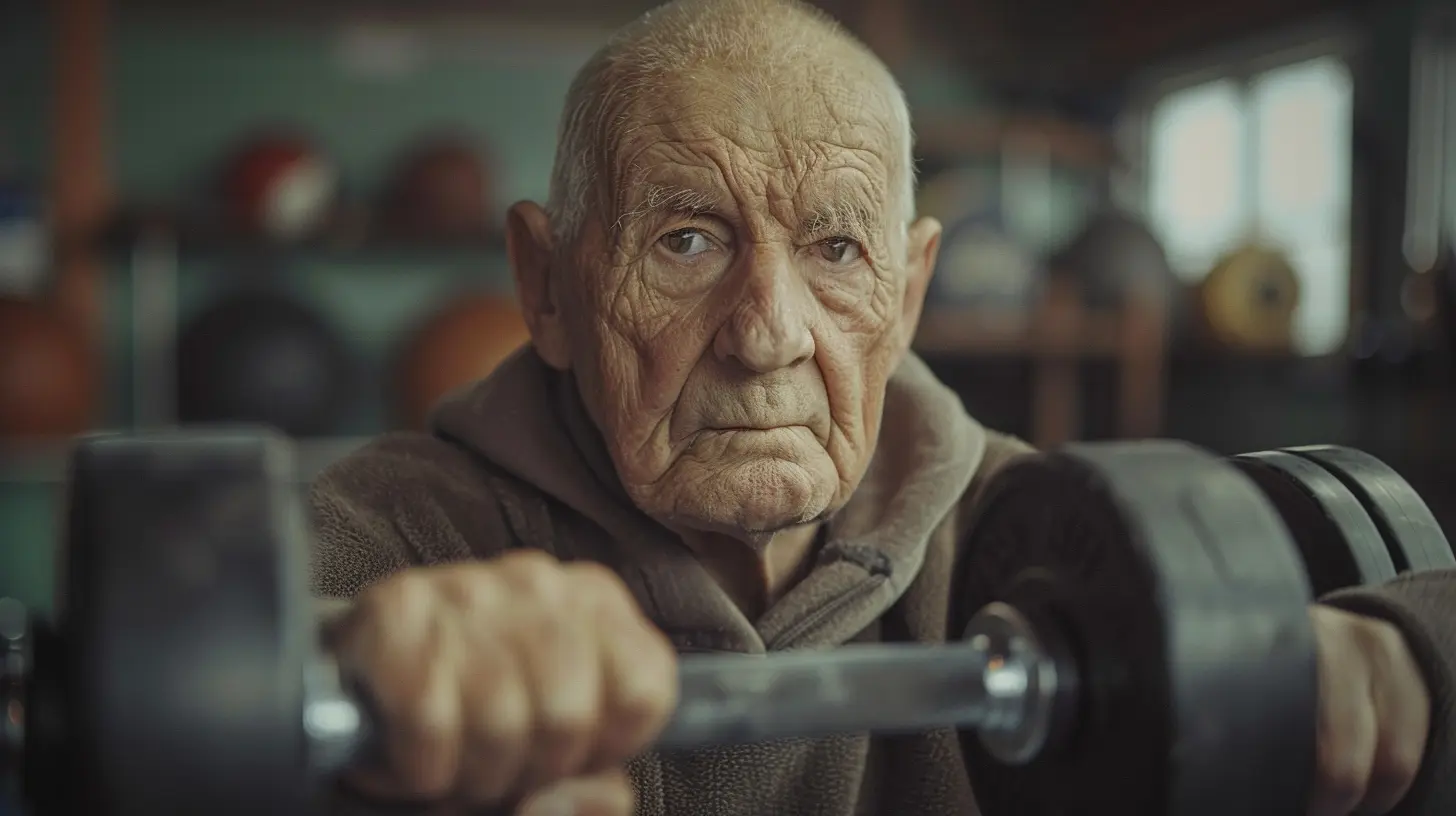Strength Training for Older Adults: Staying Strong with Age
15 January 2025
Strength training isn't just for bodybuilders or professional athletes. In fact, it's one of the most essential forms of exercise for older adults. Whether you're in your 50s, 60s, or beyond, keeping your muscles strong can have profound benefits on your overall health and quality of life.
But let’s face it — the idea of lifting weights might seem a little intimidating at first, especially if you’ve never done it before. The good news? It doesn’t have to be! Strength training is for everyone, and with the right approach, it can be a game-changer for staying strong and active as you age.

Why Strength Training Matters as You Age
As we grow older, our bodies naturally go through changes. Muscles tend to weaken, bones become less dense, and our metabolism slows down. Sounds a bit discouraging, right? But here's the kicker: these changes aren’t set in stone. You have the power to slow them down — or even reverse some of them — with strength training.By lifting weights or using resistance bands, you're telling your body, "Hey, I still need these muscles!" And guess what? Your body listens. It responds by building or maintaining muscle mass, which helps you stay mobile, independent, and healthier overall.
The Battle Against Muscle Loss
Muscle loss is a real thing, and it even has a fancy name — sarcopenia. After the age of 30, we can lose up to 3-5% of muscle mass each decade. By the time you hit your 60s, this loss becomes more noticeable. That’s why tasks that were once easy, like climbing stairs or carrying groceries, can start to feel much harder.Strength training, however, is your secret weapon against sarcopenia. When you regularly engage in resistance exercises, you maintain and even rebuild lost muscle, keeping you strong and able to tackle daily tasks with ease.
Bone Health Benefits
It’s not just your muscles that benefit from strength training — your bones do, too. Osteoporosis, which weakens bones and makes them more prone to fractures, is a common concern as we age. Weight-bearing exercises (think lifting weights or using your body weight) help stimulate bone growth and improve bone density.And let’s not forget about balance. Strong muscles and bones mean better stability, which reduces the risk of falls — a major concern for older adults.
Boosting Metabolism and Weight Management
It’s no secret that as we age, our metabolism slows down. This is partly because of the natural decline in muscle mass. Since muscle burns more calories at rest than fat does, having less muscle means you're burning fewer calories, even when you're just sitting on the couch.By building muscle through strength training, you can give your metabolism a much-needed boost. This not only helps with weight management but also improves overall energy levels. So, if you want to keep those extra pounds at bay and feel more energized, strength training is a win-win.

Getting Started with Strength Training
Okay, so now that we know why strength training is so important, how do you actually get started? The good news: it’s easier than you think! You don’t need to spend hours in the gym or lift heavy weights. In fact, a few simple exercises done consistently can make a massive difference.Start Slow and Build Up
If you’re new to strength training, there’s no need to jump in headfirst. Start slow. Begin with lighter weights or even just your body weight. The key is to focus on proper form before you increase the intensity.For instance, you could start with a basic bodyweight squat or a wall push-up. These exercises might seem simple, but they’re effective in targeting major muscle groups.
Resistance Bands: A Great Tool for Beginners
If lifting weights sounds a bit intimidating, don’t worry — resistance bands are a fantastic alternative. They’re easy to use, gentle on your joints, and provide enough resistance to challenge your muscles. Plus, they’re portable, so you can use them at home or even while traveling.The Importance of Consistency
Like anything in life, consistency is key. You don’t need to spend hours every day lifting weights, but aiming for 2-3 strength training sessions per week is a solid goal. Over time, you’ll notice improvements in your strength, balance, and overall stamina.Don’t Forget to Warm Up and Cool Down
Before diving into any strength training routine, it’s crucial to warm up your muscles first. A light cardio session like walking or cycling for 5-10 minutes can do the trick. After your workout, be sure to stretch to prevent stiffness and boost flexibility.
Best Strength Training Exercises for Older Adults
Now that you’re ready to get started, let’s talk about some of the best exercises for older adults. These moves focus on building strength, improving balance, and maintaining mobility.1. Bodyweight Squats
Bodyweight squats are a fantastic way to strengthen your legs and glutes. They mimic the movement of sitting down and standing up, which is something we do every day. Start by standing with your feet shoulder-width apart, then lower your body as if you’re sitting in a chair. Keep your chest up and your knees aligned with your toes. Aim for 10-15 repetitions.2. Wall Push-Ups
Wall push-ups are a great upper body exercise that targets your chest, shoulders, and triceps without putting too much strain on your joints. Stand facing a wall, place your hands shoulder-width apart, and bend your elbows to bring your chest towards the wall. Push back to the starting position. Try to complete 10-12 reps.3. Seated Leg Lifts
Seated leg lifts are perfect for strengthening your core and hip flexors. Sit on a chair with your back straight and feet flat on the floor. Slowly lift one leg, hold for a second, and then lower it back down. Alternate between legs, aiming for 10-15 reps on each side.4. Bicep Curls with Weights or Resistance Bands
Bicep curls are excellent for strengthening your arms. You can use light dumbbells or resistance bands for this exercise. Stand with your feet shoulder-width apart, hold the weights or bands in your hands, and slowly curl them towards your shoulders. Lower them back down and repeat for 10-15 reps.5. Bridge Pose
Bridge pose is a fantastic way to strengthen your glutes, hamstrings, and lower back. Lie on your back with your knees bent and feet flat on the floor. Slowly lift your hips towards the ceiling, hold for a second, and then lower back down. Aim for 10-12 reps.6. Chair Stands
This simple exercise helps improve both leg strength and balance. Sit in a sturdy chair, cross your arms over your chest, and stand up without using your hands. Slowly sit back down and repeat the movement 10-15 times.
Overcoming Common Barriers
It’s easy to come up with reasons to avoid strength training, especially as we get older. “I’m too old for that.” “I don’t want to get injured.” “I don’t have time.” Sound familiar?Let’s break down some of these common barriers:
“I’m Too Old to Start”
Absolutely not! People of all ages can benefit from strength training. In fact, studies show that even individuals in their 80s and 90s can build muscle and improve strength with regular resistance exercise. Age is just a number.“I’m Afraid of Getting Hurt”
It’s normal to be concerned about injuries, but when done correctly, strength training is safe and effective. Start with lighter weights or resistance bands, focus on form, and listen to your body. If you're unsure, consider working with a personal trainer who specializes in older adults.“I Don’t Have Time”
You don’t need hours of strength training to see results. Even just 20-30 minutes, two to three times a week, is enough to make a difference. Remember, it's about quality, not quantity.The Psychological Benefits of Strength Training
Beyond the physical perks, strength training also offers an array of mental and emotional benefits. Exercise is known to release endorphins, the “feel-good” hormones, which can help reduce stress, anxiety, and depression.Moreover, staying active and strong helps boost self-esteem. Knowing that you can still lift, move, and perform daily tasks independently can have a profound effect on your confidence and overall well-being.
Final Thoughts: It’s Never Too Late
Strength training is one of the best things you can do for your body as you age. It’s not about lifting the heaviest weights or becoming a bodybuilder. It’s about staying strong, mobile, and independent for as long as possible. So, whether you’re just starting out or getting back into the groove, remember that it’s never too late to begin. Your future self will thank you!all images in this post were generated using AI tools
Category:
Strength TrainingAuthor:

Easton Simmons
Discussion
rate this article
20 comments
Lys Anderson
Strength training is essential for older adults, enhancing muscle mass, bone density, and functional fitness. It promotes mobility, reduces fall risk, and supports independence. Incorporating resistance exercises into weekly routines can lead to significant health benefits and improved quality of life as we age.
March 30, 2025 at 4:38 AM

Easton Simmons
Thank you for highlighting the critical benefits of strength training for older adults! It's essential for maintaining health and independence as we age.
Keira McWain
Strength training isn’t just for the young—it's essential for everyone. Older adults deserve to build strength, boost confidence, and defy age stereotypes. Embrace the weights; it’s time to redefine what aging looks like!
February 3, 2025 at 11:57 AM

Easton Simmons
Absolutely! Strength training is vital for all ages, empowering older adults to enhance their strength, confidence, and overall well-being. Let's challenge age-related stereotypes together!
Felicity Gonzalez
This article highlights the crucial benefits of strength training for older adults, promoting health and mobility. It's essential for longevity and overall well-being. Great job!
January 28, 2025 at 5:42 AM

Easton Simmons
Thank you! I'm glad you found the article helpful in highlighting the importance of strength training for older adults.
Jacob McGowan
What a fascinating perspective on strength training for older adults! It’s inspiring to see how staying active can enhance quality of life. I’m curious about the specific benefits mentioned—do you have any recommendations for beginner-friendly exercises to get started?
January 25, 2025 at 1:24 PM

Easton Simmons
Thank you for your interest! Beginner-friendly exercises for older adults include bodyweight squats, seated leg lifts, and resistance band exercises. Always consult a healthcare provider before starting any new workout routine!
Matteo Newton
Great article! It’s inspiring to see the emphasis on strength training for older adults. Staying active and strong is so important for health and well-being at any age. Thanks for providing valuable insights that motivate us all to keep moving!
January 25, 2025 at 5:15 AM

Easton Simmons
Thank you so much for your kind words! I'm glad you found the article inspiring and motivating. Staying strong and active is indeed vital for our health at any age!
Tank Wilkerson
Great insights! Emphasizing safety and proper form is crucial for older adults to enjoy strength training benefits effectively.
January 24, 2025 at 1:38 PM

Easton Simmons
Thank you! You're absolutely right—prioritizing safety and proper form ensures older adults can safely reap the rewards of strength training.
Halle McLemore
Great article! It's inspiring to see how strength training can empower older adults to stay active and enjoy life fully.
January 24, 2025 at 3:51 AM

Easton Simmons
Thank you! I’m glad you found it inspiring—strength training truly can make a significant difference in the lives of older adults.
Bailey Love
Strength training isn't just for the young; it’s the secret sauce for aging gracefully. With each rep, older adults can defy stereotypes, proving strength is timeless and truly knows no age.
January 23, 2025 at 12:43 PM

Easton Simmons
Absolutely! Strength training empowers older adults to maintain independence and vitality, proving that age is just a number when it comes to fitness.
Jessica Jenkins
This article insightfully highlights the importance of strength training for older adults, emphasizing not just physical fitness but also enhancing mobility, independence, and overall quality of life as we age.
January 23, 2025 at 4:50 AM

Easton Simmons
Thank you for your thoughtful comment! I'm glad you found the article highlights the crucial benefits of strength training for older adults. Staying strong is key to maintaining independence and a high quality of life.
Esme McInnes
Great article! It's crucial to emphasize the importance of strength training for older adults. Staying strong not only enhances physical health but also improves overall quality of life. Thank you for shedding light on this vital topic!
January 22, 2025 at 4:06 PM

Easton Simmons
Thank you for your positive feedback! I completely agree—strength training is essential for maintaining health and quality of life as we age.
Ivory Vasquez
Essential for longevity; promotes mobility and independence.
January 21, 2025 at 9:53 PM

Easton Simmons
Absolutely! Strength training is key for maintaining mobility and independence as we age.
Will McMillen
Absolutely essential! Strength training not only enhances physical health but also boosts confidence and independence in older adults. It’s never too late to start—prioritize your strength and vitality to fully enjoy life's adventures as you age!
January 21, 2025 at 5:44 AM

Easton Simmons
Thank you for your insightful comment! I completely agree—strength training is vital for improving both physical health and overall well-being in older adults. It truly is never too late to start!
Rylan Barrett
Great article! Strength training is essential for older adults to maintain health, improve balance, and enhance overall quality of life.
January 20, 2025 at 7:22 PM

Easton Simmons
Thank you! I'm glad you found the article helpful. Strength training truly plays a vital role in promoting health and wellness as we age.
Eliana Ellison
What a wonderful article! It's inspiring to see the emphasis on strength training for older adults. Encouraging our seniors to stay active not only enhances their physical health but also boosts their confidence and well-being. Every step towards strength is a triumph—let's keep supporting each other!
January 20, 2025 at 12:10 PM

Easton Simmons
Thank you for your kind words! I'm glad you found the article inspiring. Supporting strength training for older adults is indeed vital for their health and well-being!
Luella McBride
“Strength training for older adults? Absolutely! Who says aging means slowing down? Grab those weights and prove that ‘golden years’ can flex harder than ever! It’s time to lift, laugh, and redefine what it means to grow older—stronger, sassier, and unstoppable!”
January 19, 2025 at 7:51 PM

Easton Simmons
Absolutely agree! Strength training empowers older adults to embrace their vitality and redefine aging—let’s stay strong and unstoppable together!
Tala Bishop
It's inspiring to see more resources focused on strength training for older adults. Staying active not only boosts physical health but also enhances mental well-being. Remember, every small step counts. Let's celebrate the journey of aging with strength and resilience. Keep pushing forward, and know you’re not alone in this!
January 19, 2025 at 5:11 AM

Easton Simmons
Thank you for your insightful comment! I completely agree—strength training is essential for promoting health and well-being as we age. Every step truly does matter!
Roman McIlwain
This article highlights the essential role of strength training for older adults in promoting health and vitality. It's encouraging to see a focus on lifelong fitness, as staying strong can significantly enhance quality of life. Thank you for shedding light on this important topic that supports healthier aging!
January 18, 2025 at 9:18 PM

Easton Simmons
Thank you for your thoughtful comment! I’m glad you found the article valuable in promoting strength training for healthier aging.
Wendy McNaughton
Who says getting older means getting weaker? With strength training, we can lift more than just our spirits! Here’s to bending stereotypes and dumbbells—age is just a number!
January 18, 2025 at 5:04 AM

Easton Simmons
Absolutely! Strength training empowers older adults to defy stereotypes and maintain their physical strength and vitality. Here’s to staying strong at any age!
Melissa McNeil
Oh sure, just what I need—lifting weights to stay strong while my back complains louder than my teenage kids!
January 17, 2025 at 1:49 PM

Easton Simmons
I understand the challenge! Remember, even light strength training can help support your back and improve overall strength. Start slow and listen to your body!
Carina Edwards
Strength knows no age limits!
January 16, 2025 at 1:29 PM

Easton Simmons
Absolutely! Strength training empowers individuals of all ages to maintain their health and vitality.
MORE POSTS

Premier League Showdown: Who Will Triumph in the Next Big Derby?

Snowboarding for Kids: How to Get Your Little Ones Started

Coaching Legends: What Sets Them Apart from the Rest

How to Pick the Right Goggles for Your Swim Style

Exploring Cross-Sport Endorsements: When Athletes Go Beyond Their Game

Why Some Athletes Avoid Big-Name Endorsement Deals

How Female Athletes are Dominating Sports Brand Endorsements

Trade Shockwaves: When Fan Favorites Are Sent Packing

The Mental Game: Developing Focus as an Amateur Athlete

The Science of Shooting: Tips to Perfect Your Jump Shot

Best Cardio Workouts for Toning and Sculpting Your Body

The Cultural Significance of the Olympic Flame